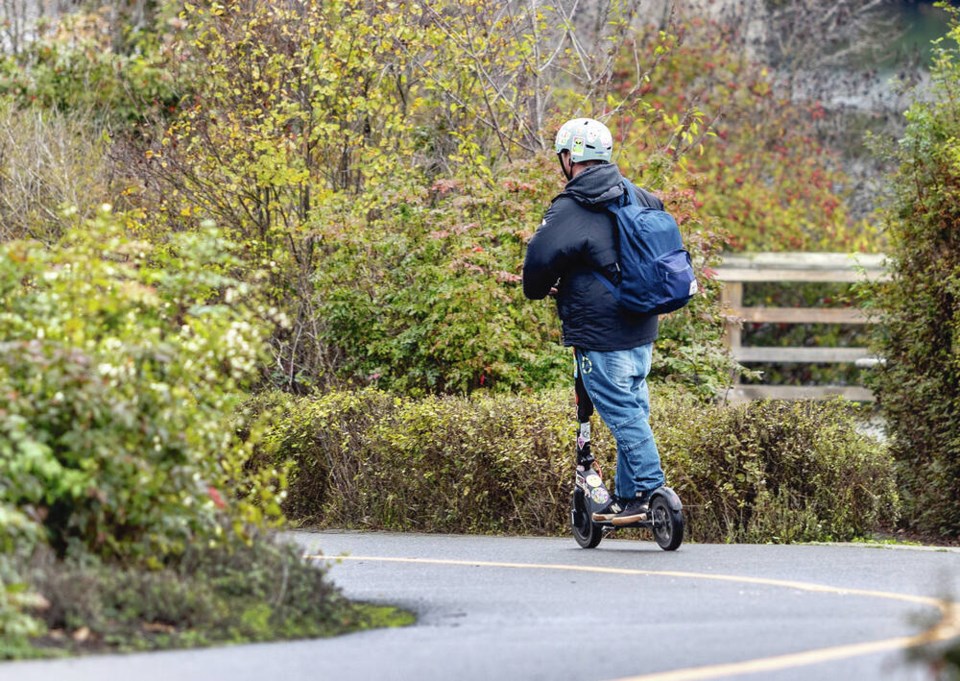The decision by Victoria council to participate in B.C.’s electric-scooter pilot project was really just a matter of time.
Starting April 5, they will be legal, as they are in a number of other pilot-project cities throughout the province.
It’s really just a rubber stamp, because as the staff policy paper to council admits, they’re “ubiquitous” anyway.
That’s partially because of the way we seem to do things today — make things like e-scooters (up till now) unlawful to operate but not unlawful to sell or possess.
Little wonder, then, their ubiquity — just as with illegal “ape hanger” motorcycle handlebars and unbaffled tailpipes. Both carry hefty fines for their use but are allowed to be sold unabated at any number of aftermarket shops.
There’s no question that the e-commute trade has exploded in the past five years and why not?
E-scooters are fun, convenient and eco-friendly — the latter point thoroughly highlighted by city staff.
There’s no question an e-scooter can help reduce congestion and greenhouse-gas emissions.
They also enable more people to have access to a new mode of transportation, and because of their compact size, extend the reach of public transportation systems.
And here comes the “but”…
Many U.S. city councils are giving the e-scooter craze second thoughts. One reason is the number of injuries that their riders incur. In 2019, a study by UCLA covering two hospitals showed there were 249 injuries reported involving e-scooters that year.
While that isn’t a large number considering the population and the amount of traffic there, the study also disconcertingly showed that 40% of those injuries involved head trauma.
A similar study from Austin, Texas showed that closer to 50% of e-scooter injuries involved head trauma.
Fortunately, the province’s e-scooter regulations include requiring the use of an approved helmet. Hopefully people will be more responsible in this regard than the many cyclists who choose to ignore helmet laws.
Another concern that has popped up in the U.S. is the number of crashes involving e-scooter riders who are drunk.
Norway also determined that in 2020, 40% of e-scooter riders involved in a crash were intoxicated. California has moved to ensure that vehicular impaired-driving standards now apply to e-scooter operators.
Scooters in B.C. are legally permitted to travel at up to 24 km/h depending on the exact location and road environment where they are operating. That’s fast.
They are also by their nature top heavy, making them more prone to tipping over than a bicycle or a motorcycle. While there are some fairly comprehensive regulations laid down by the province around their operation, no training or licensing standards apply to the operator.
While an e-scooter must not weigh more than 45 kilograms, there’s no regulation about how much the rider can weigh. That’s important because most manufacturers recommend a rider weigh less than 100 kg. A heavier payload can affect the scooter’s own capabilities.
Another concern is the size of an e-scooter’s wheels. Cracks, bumps and potholes that a vehicle driver or even a cyclist can take for granted can be trip-ending barricades for the e-scooter’s tiny wheels.
A Science Daily study last year showed e-scooters riders were 60 times more likely to experience a crash or near-crash experience during a transition from gravel or dirt to grass from a designated or shared pathway.
While B.C.’s regulations require that e-scooter operators use lights at night, there is justifiable concern about their visibility in the dark. The rear fender of an e-scooter is only a few centimetres above the ground.
Anyone who is prudent should be attaching a light to their backpack or helmet — if they’re wearing one.
For me, the jury’s still out. Alternative transportation measures are necessary today, but not at any cost.
The are worth a read:
Glove Box: I’m a big believer in the negative power of annoyance. An annoyed driver is a frustrated driver and a frustrated driver loses judgment and makes mistakes that affect all of us.
One of the biggest annoyances for drivers in south coastal B.C. is dealing with an hour and a half of car alarms during a B.C. Ferries trip.
So kudos to the crew of the Coastal Celebration ferry who, for the first time on one of my myriad excursions across the pond, announced that people should deactivate their car alarms before heading topside.
They even took it a step further by identifying the frequent flyers of the annoyance club: the BMW, the Audi and the Ford F150 pickup.
I don’t know if this is a corporation-wide policy but it should be, as I’ve yet to see a report of a vehicle being stolen during a ferry trip.



